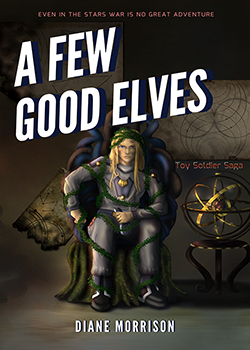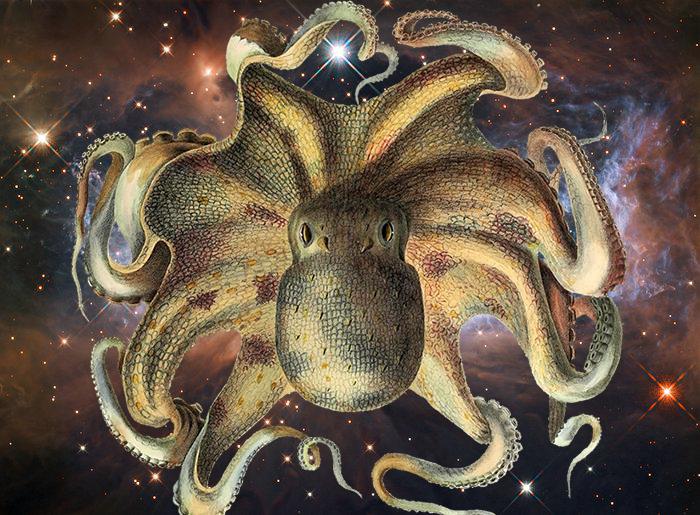Star Kraken
Capable of eating stars, the unimaginably huge star kraken is the scourge of Known Space
It is said that some species grow to fit their environments. The Deep Void of space has... a lot of space. So perhaps it should surprise no one that with a cosmic environment in which to grow, there are creatures that grow to cosmic sizes.
Long the subjects of tales in spaceport bars, but mostly dismissed as the fantastical ravings of drunken, superstitious star-sailors, star krakens do, indeed, exist. Noted naturalists Alesander Tremayne and Selnaris Khi'Marinae have written about their encounters with such creatures, each on a separate occasion. The fact that they have each encountered a separate star kraken in two different locations within the reaches of Known Space should probably terrify every starfaring civilization.
Basic Information
Anatomy
Star krakens are soft-bodied, multi-limbed molluscs, the family that includes octopuses, squids, cuttlefish, and nautiloids. It is likely they are some unimaginably huge version of octopuses. Like other cephalopods, they are bilaterally symmetric with two eyes and a beak, and their mouths at the center point of their radial tentacles. Their soft bodies can rapidly alter their shape, enabling them to squeeze through surprisingly small gaps -- if you can call anything on this scale "small". They trail their appendages behind them as they navigate the Airts. They have a siphon-like orifice that is used both for for locomotion, as they harness the Airts to propel them through space, and draw in the gasses they need to breathe. It is possible that they may require less air to breathe than terrestrial organisms, or that they can respirate gasses that most terrestrial species find toxic.
Star krakens are almost certainly invertebrates, like other cephalopods. While it is only a presumption that star kraken physiology works the same way -- due to their size and rarity, no one has been able to dissect one -- it is a reasonable presumption. Most of an octopus' brain is, as one would expect, contained within its head in a cartilaginous "skull," but its neural tissue also extends into its tentacles, which means that they move and operate with some degree of autonomy -- and it would seem observationally that the star kraken shares this unique advantage. The bulk of their major organs are located in their mantle, which is the capelike flesh between their head and tentacles.
Star krakens are immune to the effects of decompression, and they are also effectively immune to the damaging effects of cold, fire, and radiation.
Genetics and Reproduction
A male star kraken uses a specially adapted tentacle arm to deliver a bundle of sperm directly into the female's mantle cavity, after which he begins to deteriorate, and subsequently dies. The female deposits fertilized eggs in a den and cares for them until they hatch, after which she also dies.
Eggs are usually laid in planetary debris, such as an asteroid belt or the Outer Cloud of a system. Thousands of paralarval krakens hatch, but only a handful usually survive to adulthood due to the grueling conditions. Most starve, and many are eaten by the larger paralarvae and sub-adults, who are always struggling to obtain enough food to support their incredible growth.
Growth Rate & Stages
Like most cephalopods, star krakens grow quickly in their early stages. A pod of hatchling star krakens can devastate a star system. They develop through three key stages: paralarva, sub-adult, and adult. The process takes about 50 years to complete.
Star Kraken Paralarva Stats for Pathfinder 1e
Ecology and Habitats
In large part due to their nutritional requirements, star krakens prefer habitats that are generally hostile to humanoid life, and where food is plentiful. In their younger, smaller stages, they inhabit asteroid belts and other areas where space debris is thick and common. In their later stages of life, they seek out nebulae and star clusters.
Adult star krakens are large enough to produce their own Gravity Wells, and can cause disastrous tidal effects long before they make it to a system's sun.
Dietary Needs and Habits
In their paralarval and sub-adult stages, star krakens require physical mass to survive. They eat anything they can find, from regolith to raw ore, to any creatures that might inhabit the fields of debris they occupy. As they age into their adult form, star krakens grow less dependent on biomatter, and more dependent on raw energy; radiation, heat, and perhaps light. Once they achieve adulthood, they will seek out the greatest source of energy they can find: usually, their system's star.
After devouring the star and draining it of the bulk of its energy, which may lead to its own hazards (such as the star exploding into a supernova, or, in the case of larger stellar masses, collapsing into a neutron star or even a black hole,) the star kraken seeks out an Airt, and, if possible, propels itself to the largest stellar cluster within its reach.
Fortunately for the rest of the universe, a star kraken's ability to navigate the Airts is somewhat limited. It does not appear to be able to propel itself any faster than the speed of light. This limits its range and prevents the creatures from spreading across the universe, destroying every star in the Void.
Biological Cycle
Star krakens are capable of hibernating for millennia if necessary, which allows them to survive when food is scarce. As sub-adults, star krakens remain in their asteroid fields or comet nurseries, waking when they sense large fragments of planetary debris or passing starfaring ships. Adults who run the risk of starvation will propel themselves to light speed utilizing the Airts, and then allow themselves to drift on the stellar tide in a state of hibernation until they reach another star.
Additional Information
Geographic Origin and Distribution
The periphery of Known Space
Average Intelligence
Star krakens are thought to be quite intelligent, although naturalists hesitate to suggest they possess full sentience.
Perception and Sensory Capabilities
Krakens have a complex nervous system and excellent sight, and are intelligent and behaviourally diverse. It is believed that they see some degree of colour, just as terrestrial octopuses do, but lack visual acuity. It is clear from their behaviour that they must possess some ability to perceive Airts.
Tremayne writes:
It is apparent that the star kraken possesses an acute sense of smell/taste, since it is clearly able to aim itself towards the gasses it requires to sustain respiration. It is also apparent that the adult kraken must have some ability to sense the radiation, heat and energy that it requires to survive. Perhaps this is linked to its Airt sense, and it is drawn by the gravity wells of celestial bodies. This would also explain the star kraken's distressing propensity for attacking starfaring vessels. The mechanism that would be required to operate these senses remains opaque.
Symbiotic and Parasitic organisms
Often in the case of adult krakens, smaller creatures escape their notice. It is possible for entire planetary ecosystems to take up residence on their bodies, as barnacles and other parasites cluster on to space whales.
Don't forget that you can click on the blue compass on the left to access the Table of Contents at any time!

Want to read all of the Toy Soldier Saga fiction, even before the rest of the world does?Subscribe now!
Scientific Name
Enteroctopus Universum
Lifespan
About 100 years of activity, but can hibernate for centuries
Conservation Status
Fortunately for the rest of the universe, Star Krakens are incredibly rare.
Average Height
1 to 5 stellar units (diameters of an average yellow star)
Average Weight
1 to 5 stellar masses
Average Length
1 to 2 stellar units
Body Tint, Colouring and Marking
Star krakens are thought to come in a variety of colourations and patterns, many of which suggest the prominent colours of the prevailing environment. They may even exhibit bioluminescence in patterns resembling local stars, nebulae, and other celestial features. Unlike terrestrial octopuses, they are unlikely to utilize fantastic colourful displays to attract a mate, since it is likely that due to their rarity, they will mate with the first kraken of the opposite sex they encounter.
Geographic Distribution
Discovered by





HMS Nautilus reporting for duty!
World Anvil Founder & Chief Grease Monkey
Twitter | World Anvil Changelog
“No act of kindness, no matter how small, is ever wasted.” - Aesop
Fantastic! Save us from the Scourge of the Spaceways! :D